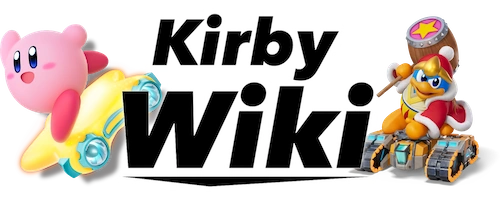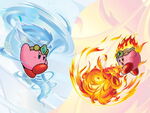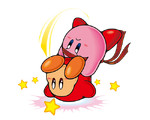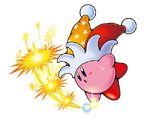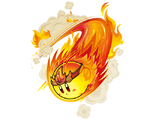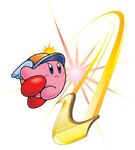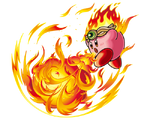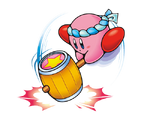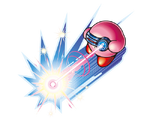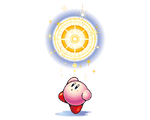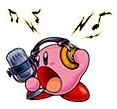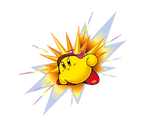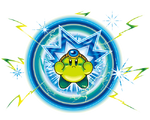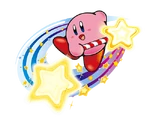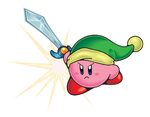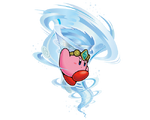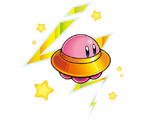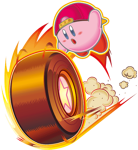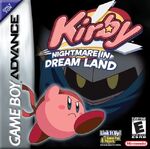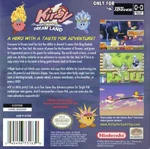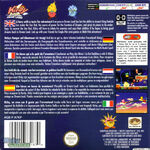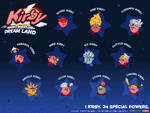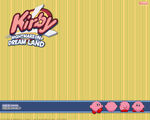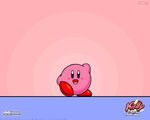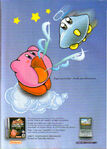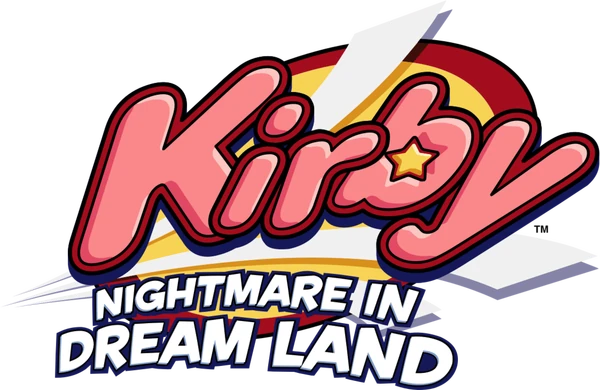| “ | This remake of Kirby's Adventure included many new features, including the ability to play with up to three friends! Each player controlled his or her own Kirby, and each Kirby could grab his own separate Copy Abilities.” |
| — Summary • Kirby's Dream Collection Special Edition |
Kirby: Nightmare in Dream Land is a platformer Kirby game developed by HAL Laboratory and published by Nintendo for the Game Boy Advance. It was released in Japan on October 25, 2002, in North America on December 2, 2002, and in Europe on September 26, 2003. A remake of the 1993 Nintendo Entertainment System (NES) platform game Kirby's Adventure, it features updated graphics and sound, and new sub-games.
Kirby: Nightmare in Dream Land has been re-released on the Wii U Virtual Console in October 2014.
Story
Intro
When the logos show up, one Kirby runs to the left, then 120 of them dash by in the same direction. One of them trips and is kicked off-screen by the second to last Kirby. Although this intro shows many Kirbys, only four were known at the time: Red Kirby, Yellow Kirby, Green Kirby and regular Kirby. Oddly, the classic intro from the NES game is missing entirely, as is the tutorial when waiting on the title screen.
Main Story
| “ | The peaceful world of Dream Land is in great danger. In Dream Land, dreams had always flowed out of the wonderful Fountain of Dreams, which the Fountain of Dreams collected the hopes and dreams of all living things. It also provided all the good dreams and rest that come from deep sleep. But one day, everyone in Dream Land lost the ability to dream! Apparently, King DeDeDe had been bathing in the Fountain of Dreams! Not only that, but DeDeDe had taken the Star Rod — the source of power of the Fountain of Dreams — and broken it into pieces, giving one to each of his underlings. Now, Kirby must embark on an adventure to restore peaceful naptimes to all residents of Dream Land...” |
| — The Adventure Begins • Kirby: Nightmare in Dream Land Instruction Booklet |
| “ | The peaceful world of Dream Land is in great danger. In Dream Land, dreams always flowed out of the wonderful Fountain of Dreams. The Fountain of Dreams collected the hopes and dreams of all living things. It was also responsible for the sweet dreams and rest that come from deep sleep. But one day, everyone in Dream Land lost the ability to dream! King DeDeDe was bathing in the Fountain of Dreams! He had even taken the Star Rod—the source of power of the fountain's power—and broken it into pieces that he gave to his underlings. Now, Kirby must embark on an adventure... to restore peaceful naptimes to all residents of Dream Land...” |
| — The Fountain of Dreams • Kirby: Nightmare in Dream Land |
The game starts with Kirby taking a nap, but something's wrong. Kirby has had no dreams, a truly unusual event in Dream Land. Kirby decides to visit the Fountain of Dreams, where all dreams spring from, to see if anything bad has happened to it. Upon his arrival, he finds King Dedede bathing in its waters. He finds that Dedede has broken the Star Rod, the power source of the fountain, into seven pieces, giving six pieces to his friends and keeping one himself. Kirby decides to track down the fragments to restore peaceful sleep and order to Dream Land.
Kirby manages to defeat King Dedede at the Fountain of Dreams and replaces the Star Rod, but Nightmare appears right after. Nightmare absorbs the powers from the Fountain and flies into the sky. King Dedede inhales Kirby and sends him after Nightmare, where they battle on Planet Popstar's moon. Kirby manages to defeat Nightmare, and the explosion ends up making a large circular hole in the moon, making it crescent-shaped. Kirby returns to the Fountain of Dreams and places the Star Rod back in there, and everything returns to normal with the dreams back in Dream Land. Dedede's prior actions are then revealed to have been part of his plan to protect the Fountain from Nightmare, then Kirby and Dedede reconcile.
Gameplay
Kirby: Nightmare in Dream Land is a traditional platformer Kirby game; the player controls Kirby, whose objective is to get to the end of each stage using Copy Abilities. Each stage is broken up into small sections ending in a door leading to the next section. At the end of each level (roughly 5 or 6 stages) is a boss fight which Kirby must win to get a piece of the Star Rod back.
For the most part, the game plays similarly to its original NES incarnation. Level designs were left mostly intact, with alterations along with some minor retooling of areas to suit the new graphical style.
Some new additions to the remake include 4-player support, 32-bit graphics, a decrease in difficulty, hats for most abilities, the three main sub-games from Kirby's Adventure being replaced by new ones, certain enemies from the original being replaced with new ones, and certain changes to certain levels. In addition, there are changes in the mechanics of certain Copy Abilities (Needle Kirby's spikes do not retract automatically, Wheel Kirby can drive on water, Backdrop Kirby dash-and-grabs enemies instead of inhale-and-grabbing them).
Meta Knight, Kirby's rival, also makes his debut playable appearance in the sub-game Meta Knightmare after completing Extra Mode with Kirby. Meta Knightmare is like playing Extra Mode but as Meta Knight. He has three health points, cannot save, and uses various sword techniques instead of copying abilities.
Kirby's moveset includes the inhale, Star Spit, Slide, Air Gun, and floating.
Multiplayer
The game supports multi-player, with up to four players. Each player plays as a member of Kirby's species. Player 1 is Kirby, Player 2 is a Yellow Kirby, Player 3 is a Red Kirby, and Player 4 is a Green Kirby.
For Story Mode and Boss Endurance, there is a cooperative mode. No player characters have any differentiation in their abilities, nor do their Copy Abilities (because of this, one may be confused if multiple Kirbys have an ability like Needle or Ice, and thus their skin colors will be uniform if they have those abilities).
In Kirby: Nightmare in Dream Land’s Co-op mode, there are some basic rules:
- All players start on the highest level that all four players have completed.
- All players automatically enter the first door that any one of the players enters.
- No one can enter the doorway unless all of the players are grouped near the doorway.
- It is also possible to call other players for help.
For all three sub-games, there is a competitive mode.
Modes
Main Games
- Story Mode
- Extra Game
Sub-games
Kirby: Nightmare in Dream Land contains three new sub-games, replacing the ones from Kirby's Adventure. Many of these games have Kirby competing with differently colored "Kirbys".
Bomb Rally
| Main article: Bomb Rally |
Kirby uses a frying pan to hit a bomb to the other Kirby. Each time one misses, the bomb explodes and that Kirby is out (replaced by Bubbles). The last Kirby left wins.
Kirby's Air Grind
| Main article: Kirby's Air Grind |
Kirby grinds on rails using the Warp Star to gain speed and race, but slows down if he tries to grind on rough black rails. The sub-game's name is similar to the racing video game Kirby Air Ride, which came out a year later.
Samurai Kirby
| Main article: Samurai Kirby |
Although having the title of Quick Draw from Kirby's Adventure, it is an updated version of Samurai Kirby from Kirby Super Star. The same enemies in the original sub-game are fought, but Kirby will only use the fan as his weapon.
Arena
| Main article: Arena |
Arena is only available in Story Mode. Kirby can enter every Arena as often as he wishes, and the primary motivation for completing it is to acquire Copy Abilities not available inside Museums and a Maxim Tomato after defeating every mid-boss.
Boss Endurance
| Main article: Boss Endurance#Kirby's Adventure and Kirby: Nightmare in Dream Land |
Boss Endurance mode is unlocked by beating the game once.
Meta Knightmare
| Main article: Meta Knightmare |
The player can play through the entire game as Meta Knight, but can't save.
Goal Game
The goal game is carried over from Kirby's Adventure. Kirby jumps on a spring platform. The goal is to press the A button when the platform is at its lowest - this sends Kirby to the top level and nets a 1UP. Otherwise the player scores between 5,000 to 100 points depending on how close the timing is to perfect. Kirby's Return to Dream Land’s goal game uses the same mechanic.
Characters
| The following section contains transcluded content from the Database. Source: (view • edit • help) |
Playable Characters
Enemies
Blade Knight | Blipper | Bomber | Gip | Bronto Burt | Broom Hatter | Bubbles | Bugzzy Jr. | Cappy | Chilly | Coner | Cool Spook | Drill Ball | Explosive Coconut | Flamer | Glunk | Gordo | Hot Head | Kabu | Laser Ball | Noddy | Parasol | Parasol Waddle Dee | Pengy | Poppy Bros. Jr. | Rocky | Scarfy | Shotzo | Sir Kibble | Slippy | Sparky | Squishy | Starman | Sword Knight | Needlous | Twister | Twizzy | UFO | Waddle Dee | Waddle Doo | Walky | Wheelie
Mid-Bosses
Bonkers | Bugzzy | Fire Lion | Grand Wheelie | Meta-Knights (Axe Knight / Javelin Knight / Mace Knight / Trident Knight) | Mr. Frosty | Mr. Tick Tock | Phan Phan | Poppy Bros. Sr.
Bosses
- Whispy Woods (Vegetable Valley)
- Paint Roller (Ice Cream Island)
- Mr. Shine & Mr. Bright (Butter Building)
- Kracko (Grape Garden)
- Heavy Mole (Yogurt Yard)
- Meta Knight (Orange Ocean)
- King Dedede (Rainbow Resort)
- Nightmare (Fountain of Dreams)
Copy Abilities
Kirby: Nightmare in Dream Land contains 25 Copy Abilities, all of which return from Kirby's Adventure.
Backdrop |
Ball |
Beam |
Burning |
Crash |
Cutter |
Fire |
Freeze |
Hammer |
Hi-Jump |
Ice |
Laser |
Light |
Mike |
Needle |
Parasol |
Sleep |
Spark |
Star Rod |
Stone |
Sword |
Throw |
Tornado |
UFO |
Wheel |
Items and Objects
| The following section contains transcluded content from the Database. Source: (view • edit • help) |
Levels
- Vegetable Valley
- Ice Cream Island
- Butter Building
- Grape Garden
- Yogurt Yard
- Orange Ocean
- Rainbow Resort
- The Fountain of Dreams
List of Differences from Kirby's Adventure
- Some new additions to the remake include 4-player support (as opposed to the single-player experience of the original), 32-bit graphics (as opposed to 8-bit), a decrease in difficulty, hats for most abilities (a feature introduced in Kirby Super Star), the three main sub-games from the original Kirby's Adventure being replaced by new ones, certain enemies from the original being replaced with new ones (Phan Phan replaced Rolling Turtle, Needlous replaced Togezo, and Gip replaced Bounder) and certain changes to certain levels. In addition, there are changes in the mechanics of certain Copy Abilities (Needle Kirby's spikes do not retract automatically, Wheel Kirby can drive on water, Backdrop Kirby dash-and-grabs enemies like Suplex rather than inhale-and-grabbing them). Several enemies (including bosses) also now have designs based on their appearances in Kirby Super Star (such as Rocky having a headband).
- There are also some differences in what music is played during certain situations: In Stage 2 of Vegetable Valley, the underground/sky theme of the game is replaced by Ice Cream Island's theme. Also, a remix of the Kirby 64: The Crystal Shards mid-boss music now plays when fighting the Meta-Knights instead of the normal boss music, which is also replaced in the fight against King Dedede by a remix of the Fountain of Dreams' music from Super Smash Bros. Melee. Additionally, in Stage 2 of Rainbow Resort, the Arena music no longer plays, but rather, a version of King Dedede's theme plays.
- After beating Extra Mode, the player will unlock "Meta Knightmare!", a sub-game that lets the player go through the game (minus the fight with Nightmare) as Meta Knight, with Extra Mode's three bars of vitality as a challenge, and with Meta Knight's sword, as he cannot inhale enemies. Also, the player cannot save in this sub-game, so he/she must play all in one go. Strangely enough, Meta Knight encounters himself but does not end up fighting Nightmare. This game mode is also timed and the greatest speed is saved. This idea was greatly expanded in Meta Knightmare Ultra from Kirby Super Star Ultra, which then gave Meta Knight his own solo storyline.
- However, on top of all the upgrades are some gameplay and aesthetic downgrades. The graphics, while vibrant, were different at the time to the established Kirby style - the imagery seems to be very twisty and distant compared to the other games in the series, and the backgrounds are now static and are never animated. Hidden doors are more easily noticed as they are marked with certain objects, such as ventilation shafts, holes, and (most commonly) darkened areas. Several instances that pushed the NES hardware to its capabilities were strangely removed, such as Butter Building's rotating towers (which makes the Wheel ability far less useful around there). While the Ball and Hi-Jump abilities were upgraded, most abilities like Fire and Cutter were given some lag time due to the new frames of animation. While Tornado Kirby in the NES version remains invincible during the end of his animation while attacking an enemy, Tornado Kirby in the GBA version will get damaged while his animation is ending while attacking an enemy. Most of the bosses and all of the mid-bosses were made larger, but they are now somewhat clumsy and are not as threatening and precise as their NES counterparts (aside from the esoteric route found at the beginning of 7-2 and Phan Phan in 6-1). Outside of possibly Meta Knightmare, the game was generally made easier and more forgiving (as was common with Nintendo's other Game Boy Advance ports).
Music
| Main article: Kirby: Nightmare in Dream Land/Music |
Glitches
| Main article: Glitch#Kirby: Nightmare in Dream Land |
Reception
| This section is currently under construction | |
Transcript
| Main article: Kirby's Adventure and Kirby: Nightmare in Dream Land/Transcript |
Staff
| Main article: List of Kirby: Nightmare in Dream Land Staff |
Trivia
- Kirby: Nightmare in Dream Land was promoted in commercials in the animation style of Kirby: Right Back at Ya!
- This commercial features a parody of the song "Secret Agent Man" by Johnny Rivers.
- Furthermore, most character designs in the anime are based on their appearance in Kirby: Nightmare in Dream Land.
- When Kirby: Nightmare in Dream Land is turned on, no less than 120 Kirbys rush across the title screen.
- Kirby: Nightmare in Dream Land was the first Kirby game for a handheld system that allowed the hero to dash. Fittingly, it is a remake of the game that introduced Kirby's dash ability.
- The first letters of each level (except for the Fountain of Dreams) spell out VIBGYOR, the acronym for the colors of the rainbow (backwards). This trait is directly carried over from the original NES version.
- Kirby: Nightmare in Dream Land is the final game that Shinichi Shimomura (a longtime level designer for the Kirby series and the director of Kirby's Dream Land 2, Kirby's Dream Land 3, and Kirby 64: The Crystal Shards) contributed to before his sudden and unexplained disappearance from the public eye; Shimomura served as co-director of Kirby: Nightmare in Dream Land alongside series creator Masahiro Sakurai. [citation needed]
- This was the first Kirby title whose international release reappropriated the logo for Kirby: Right Back at Ya! rather than using the logo that had been in place from Kirby's Dream Land to Kirby Tilt 'n' Tumble. From this point on, all future games would reuse the Kirby: Right Back at Ya! logo, sometimes altering its color scheme to fit a certain design.
- Oddly, when a boss is defeated, there is a sound of crowd cheering. Most other games do not have this, except in an arena stage that takes place in a stadium.
- It is possible that the sound producers misheard the crashing sound effect from the boss defeat sequence in older Kirby games or placed the sound effect used in arena stages.
- According to programmer Eitaro Nakamura, the development staff struggled to get four-player co-op working sufficiently. It did not work properly until "one or two months" before its deadline.[3]
